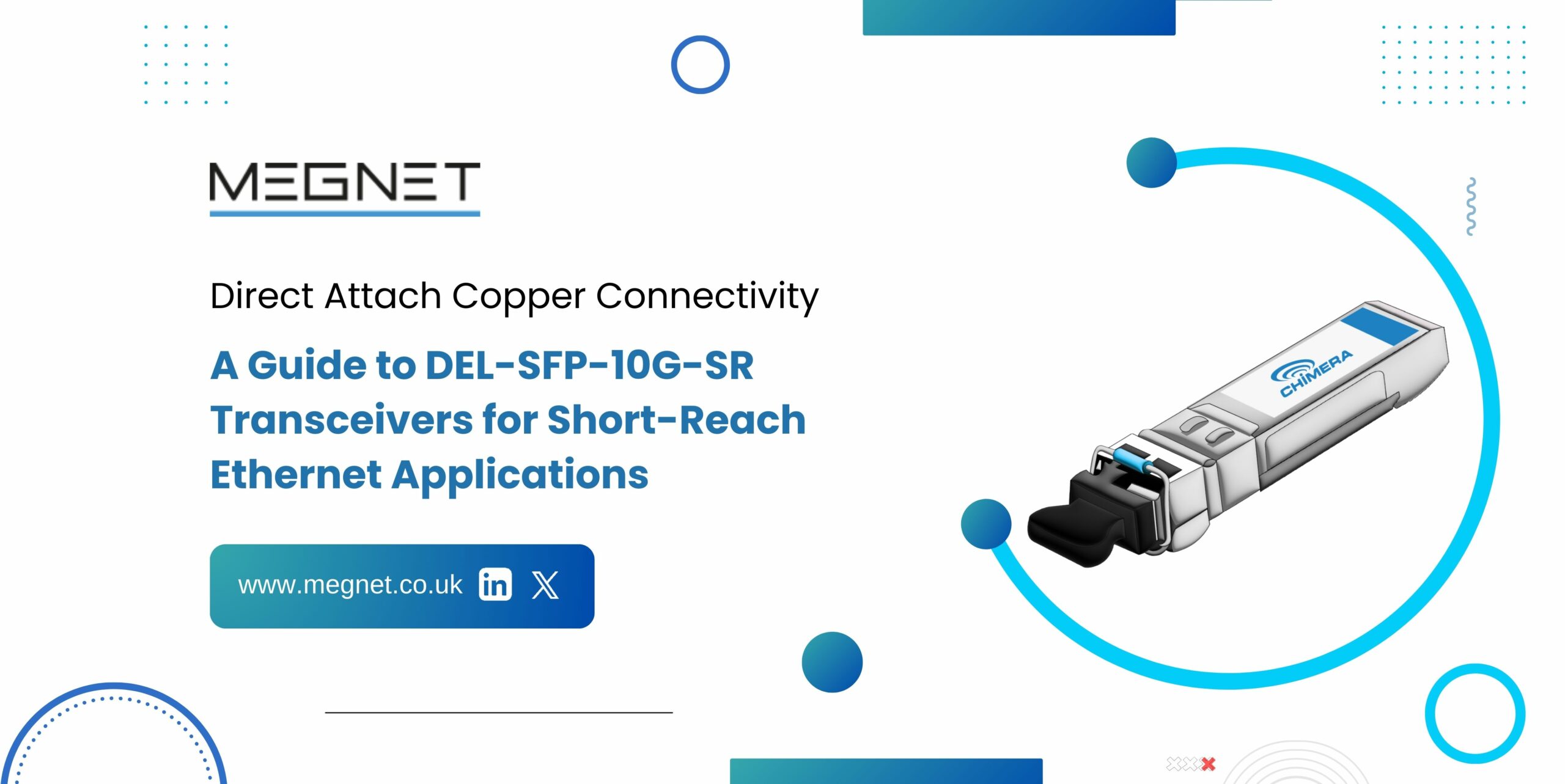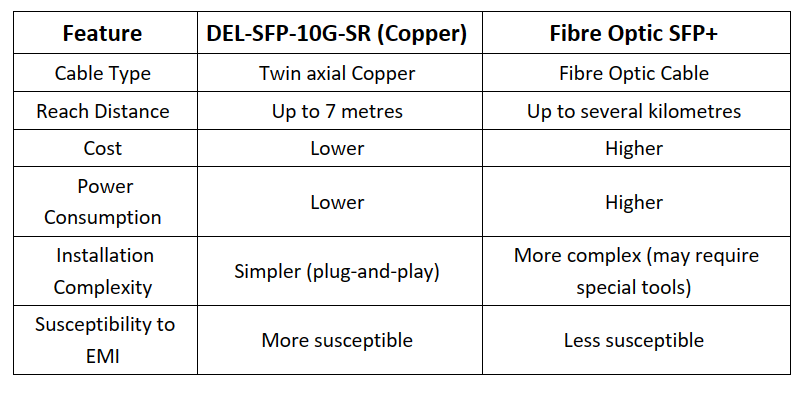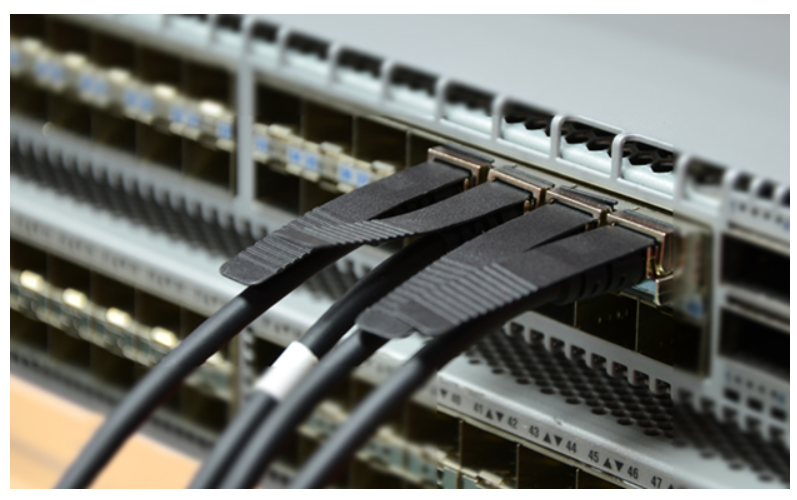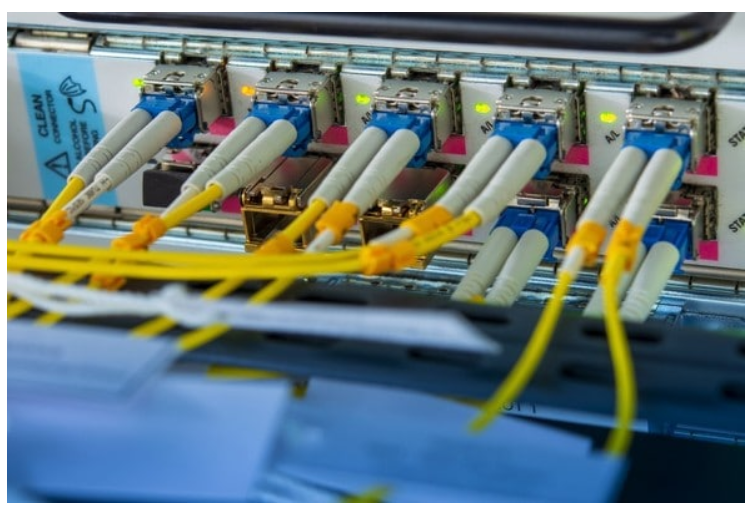
Unleash High-Speed Efficiency with DEL-SFP-10G-SR Transceivers
The ever-increasing demand for data in today’s enterprise networks necessitates high-speed and dependable data transfer. While 10 Gigabit Ethernet (10GbE) has become the backbone for handling this data surge, implementing such high-speed solutions can be expensive, especially for shorter distances within a rack or data centre. This is where the DEL-SFP-10G-SR transceiver steps in.
This blog dives into the world of DEL-SFP-10G-SR transceivers, exploring their technical specifications, advantages over traditional fibre optic solutions, and ideal use cases within data centres and enterprise networks.
We’ll also delve into key considerations for selecting and deploying these transceivers for optimal performance. By the end of this comprehensive guide, you’ll be equipped with the knowledge to determine if DEL-SFP-10G-SR transceivers are the right fit for your short-range, high-bandwidth Ethernet applications.
Understanding DEL-SFP-10G-SR Transceivers
The DEL-SFP-10G-SR transceiver plays a vital role in facilitating high-speed data transmission within data centres and enterprise networks for short-range applications. This section delves deeper into its technical specifications, functionalities, and key advantages compared to other 10 Gigabit Copper SFP+ Transceiver options.
Technical Specifications:
Data Rate: 10 Gigabit per second (Gbps): The DEL-SFP-10G-SR transceiver supports a blazing-fast data rate of 10 Gbps, enabling seamless transfer of large data packets ideal for bandwidth-intensive applications like video streaming, cloud computing, and data storage.
Reach Distance: Up to 7 metres: This transceiver is specifically designed for short-range applications, offering a maximum reach distance of approximately 7 metres. While this might seem like a limitation, it caters perfectly to intra-rack or inter-rack connections within data centres, making it a cost-effective choice for these scenarios.
Interface: SFP+ (Small Form-Factor Pluggable Plus): The DEL-SFP-10G-SR adheres to the SFP+ industry standard, ensuring compatibility with a wide range of network switches, routers, and other networking equipment that feature SFP+ ports. This widespread compatibility allows for greater flexibility in network design and integration.
Cable Type:
Twinaxial Copper Cabling: Unlike fibre optic transceivers that utilise light pulses for network data transmission, the DEL-SFP-10G-SR employs twinaxial copper cabling. This type of cable features two insulated conductors twisted around each other within a shielded enclosure, minimising signal interference and ensuring reliable data transmission over shorter distances.
Functionalities and Advantages:
Hot-Swapping: The SFP+ form factor enables hot-swapping functionality. This means the DEL-SFP-10G-SR transceiver can be inserted or removed from a compatible SFP+ port while the network equipment is still operational. This allows for easy maintenance and troubleshooting without network downtime.
Digital Diagnostics Monitoring: Many DEL-SFP-10G-SR transceivers offer digital diagnostics monitoring capabilities. This feature provides valuable real-time insights into critical operating parameters like transceiver temperature, laser bias current, transmitted and received optical power (for fibre optic SFP+ transceivers), and transceiver supply voltage. This information is crucial for monitoring performance, identifying potential issues, and ensuring optimal network health.
Cost-Effective Solution: Compared to fibre optic SFP+ transceivers, the DEL-SFP-10G-SR offers a significant cost advantage. The use of copper cabling and the suitability for shorter distances make it a more budget-friendly option for intra-rack or inter-rack connections.
Lower Power Consumption: Copper cabling generally consumes less power compared to fibre optic cables. This translates to lower operational costs for data centres and contributes to an eco-friendlier network infrastructure.
Simple Installation: The DEL-SFP-10G-SR transceiver with its twinaxial copper cabling offers a simpler installation process compared to fibre optic solutions. The plug-and-play nature of SFP+ transceivers further simplify deployment, minimising installation time and complexity.
Comparison with Fibre Optic SFP+ Transceivers:
While both DEL-SFP-10G-SR and fibre optic SFP+ transceivers facilitate 10GbE connectivity, they cater to distinct needs within a network. Here’s a breakdown of their key differences:

10GbE Copper Connectivity with DEL-SFP-10G-SR

The DEL-SFP-10G-SR transceiver unlocks the potential of 10 Gigabit Ethernet (10GbE) copper connectivity, offering a compelling alternative to traditional fibre optic solutions for short-range applications within data centres and enterprise networks. This section delves deeper into the advantages of using DELL SFP+ DAC and transceivers and explores considerations for optimal deployment.
Cost-Effectiveness
One of the most significant advantages of DAC with DEL-SFP-10G-SR transceivers is its cost efficiency. Compared to fibre optic solutions, the upfront cost of both the transceivers and the copper cabling is significantly lower. This makes it an ideal choice for budget-conscious network deployments, particularly for shorter distances where the cost advantage of fibre becomes less pronounced.
Lower Power Consumption
Beyond the initial cost savings, DAC solutions using the DEL-SFP-10G-SR transceiver contribute to lower operational expenses. Internal copper cabling inherently consumes less power compared to fibre optic cables. This translates to reduced energy consumption and lower electricity bills for data centre operations. In today’s environmentally conscious landscape, this translates to a greener network infrastructure.
Simple Installation and Flexibility
DAC offers a significant advantage in terms of installation simplicity. Unlike fibre optic solutions that might require specialised tools and expertise for cable termination, the DEL-SFP-10G-SR transceiver facilitates a plug-and-play approach. This translates to faster deployment times and reduced installation costs.
Additionally, copper cabling offers greater flexibility when planning network layouts within a rack or data centre. The bend radius of copper cables allows for easier routing compared to fibre optic cables, providing more design freedom for network architects.
Data Transmission Considerations
While DAC using DEL-SFP-10G-SR transceivers offers substantial benefits, it’s crucial to consider its limitations. The primary limitation is reaching distance. The DEL-SFP-10G-SR is designed for optimal performance at distances up to 7 metres.
Exceeding this recommended length can lead to signal degradation and potential performance issues. For longer distances, fibre optic solutions remain the preferred choice.
Electromagnetic Interference (EMI)
Another factor to consider is susceptibility to electromagnetic interference (EMI). Copper cabling is inherently more susceptible to EMI compared to fibre optic cables. In environments with high levels of EMI, such as close proximity to power lines or electrical equipment, signal integrity might be affected. In such scenarios, fibre optic solutions offer superior immunity to EMI, making them a more reliable choice.
Use Cases for DEL-SFP-10G-SR Transceivers

The DEL-SFP-10G-SR transceiver shines in various applications within data centres and enterprise networks for short-range, high-bandwidth connections. Here is a detailed exploration of its prime use cases:
High-Performance Computing (HPC) Environments
In HPC clusters where numerous servers collaborate on complex calculations, rapid data exchange is paramount. The DEL-SFP-10G-SR transceiver facilitates high-speed connections between servers within a rack, enabling efficient data transfer for parallel processing tasks. This translates to faster computation times and improved overall performance in HPC applications.
Storage Area Networks (SANs)
Modern SANs demand reliable and high-throughput connections to ensure smooth data access for critical applications. The DEL-SFP-10G-SR transceiver proves ideal for interconnecting storage devices like Fibre Channel SAN directors or iSCSI gateways within a rack or across adjacent racks. Its cost-effectiveness makes it an attractive option for short-distance connections within a SAN, optimising storage performance and accessibility.
Network Convergence
Network convergence involves consolidating multiple network types (voice, data, and video) onto a single converged network infrastructure. The DEL-SFP-10G-SR transceiver can be instrumental in this process. By enabling high-bandwidth connections between network switches within a rack, it supports the convergence of different network traffic types, leading to a more simplified and efficient network architecture.
Server Consolidation and Virtualization
As businesses virtualize their server environments, high-bandwidth connections become essential for seamless communication between virtual machines and physical servers. The DEL-SFP-10G-SR transceiver facilitates these connections within a rack, enabling efficient server consolidation and virtualization. This translates to better resource utilisation, improved scalability, and reduced operational costs.
Cloud Computing Infrastructures
Cloud computing relies on robust data centre networks to support on-demand access to resources. The DEL-SFP-10G-SR transceiver can be a valuable asset within cloud data centres. Its cost-effective, high-speed connectivity can be used for short-range connections between top-of-rack switches and servers, optimising data transfer within the cloud infrastructure. This contributes to efficient resource allocation and delivery of cloud services.
Selection and Deployment Considerations

Selecting the right DEL-SFP-10G-SR transceivers and deploying them correctly are crucial for optimal performance and compatibility within your network. Here’s a detailed breakdown of key considerations for optical transceivers:
Compatibility:
Verify Compatibility: Before purchasing DEL-SFP-10G-SR transceivers, ensure compatibility with your specific network equipment. Consult the manufacturer’s specifications for your switches, servers, or other devices to confirm supported transceiver types. Using incompatible transceivers can lead to malfunctions, errors, or even damage to equipment.
Cable Length:
Respect Distance Limitations: DEL-SFP-10G-SR transceivers are designed for short-range applications, typically with a maximum reach distance of 7 metres. Exceeding this recommended length can degrade signal quality and lead to performance issues like increased bit error rates. For longer distances, consider fibre optic SFP+ transceivers.
Cable Quality Matters: Invest in high-quality DAC cables specifically designed for 10GbE applications. These cables are constructed with impedance-matched components to minimise signal distortion and ensure reliable data transmission.
Deployment Best Practices:
Electrostatic Discharge (ESD) Protection: Handle DEL-SFP-10G-SR transceivers with care to prevent damage from electrostatic discharge. Ground yourself and wear an ESD wrist strap when handling these sensitive components. Store them in their original anti-static packaging or a conductive storage box when not in use.
Cleanliness is Key: Maintain a clean and dry environment for both the transceivers and their connection points on your network equipment. Dust, debris, or moisture buildup can hinder proper connection and signal transmission. Use compressed air or appropriate cleaning wipes to remove dust from SFP+ ports before inserting the transceiver.
Follow Installation Instructions: Each network device might have slightly different SFP+ transceiver installation procedures. Carefully follow the manufacturer’s instructions for your specific equipment to ensure proper connection and functionality. This may involve unlocking a latch, inserting the transceiver in the correct orientation, and then securing it in place.
Safety First: When working with high-speed networking equipment, prioritise safety. Turn off and unplug devices before installing or removing transceivers. Avoid touching live electrical components and be mindful of potential hazards like sharp edges or pinch points within equipment racks.
Conclusion
The DEL-SFP-10G-SR transceiver emerges as a game-changer for short-range, high-bandwidth applications within data centres and enterprise networks. Its cost-effectiveness, lower power consumption, and ease of deployment make it a compelling alternative to fibre optic solutions, particularly for distances within a rack or data centre.
By leveraging DAC technology, the DEL-SFP-10G-SR empowers businesses to achieve efficient and scalable 10 Gigabit Ethernet copper connectivity. To explore the DEL-SFP-10G-SR transceiver further and discover how it can optimise your network, visit Megnet, a leading supplier of networking solutions.
FAQ's
These transceivers are ideal for short-range, high-bandwidth connections within a data centre or rack, such as between switches and servers.
No, due to their limited reach distance (around 7 metres), they are not suitable for long-distance applications. Fibre optic solutions are better for such scenarios.
Compatibility with your network equipment and cable length limitations (typically 7 metres) are crucial factors. Opt for compatible DEL-SFP-10G-SR transceivers for optimal performance.
Always follow the manufacturer's installation instructions. It involves inserting the transceiver into the SFP+ port on your network device.
Yes, they are generally more cost-effective, making them a good choice for budget-conscious deployments over short distances.
Yes, copper cabling used by these transceivers consumes less power compared to fibre optic enterprise network solutions, leading to lower operational costs.
The cost can vary depending on the vendor and market conditions, but they are generally less expensive than fibre optic transceivers.
Multimode fibre works well for shorter distances at high speeds, while single mode fibre is ideal for longer distances and future proofing your network.
There might be regional regulations regarding electrical safety or cable usage. Consult relevant authorities if unsure.








Leave a comment
Your email address will not be published. Required fields are marked *